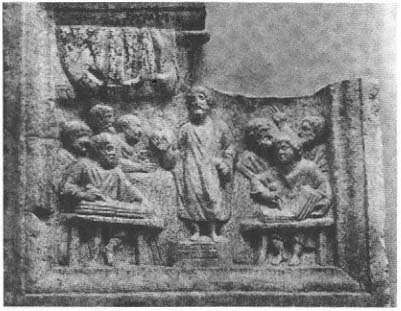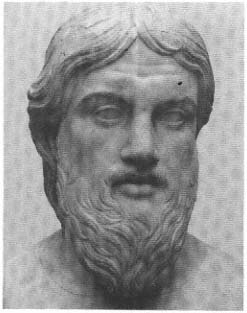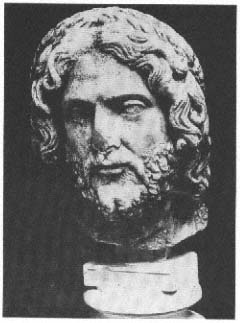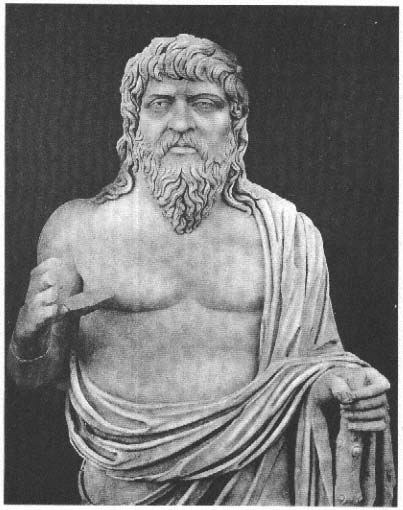The Long Hair of the Charismatics
Let us return to the age of Nero and the Flavian emperors, for it is in this period that we hear for the first time of a new breed of philoso-
pher, who is celebrated not only for his towering wisdom, but for his extraordinary spiritual powers. Unlike the itinerant Cynics, these men came from wealthy and distinguished families, and, as opposed to the house philosophers, they taught publicly and gained access to the most exclusive circles of society. They had a special aura about them, as if elevated above the rest. Pliny the Younger, in A.D. 97, describes with great admiration one of these wise men, named Euphrates, who came from a prominent Syrian family. As a young man Pliny had established a close relationship of mutual trust with him, and after the death of Domitian, Euphrates taught publicly in Rome.[73] He is described as follows:
As far as I am qualified to determine, Euphrates is possessed of so many shining talents, that he cannot fail to strike and engage even the somewhat illiterate. He reasons with much force, penetration, and elegance, and frequently embodies all the sublime and luxuriant eloquence of Plato. His outward appearance is agreeable to all the rest: he has a tall figure, a comely aspect, long hair, and a large white beard: circumstances which though they may probably be thought trifling and accidental, contribute however to gain him much reverence [plurimum venerationis ]. There is no uncouthness in his manner, which is grave, but not austere; and his approach commands respect without creating awe. Distinguished as he is by the sanctity of his life [sanctitas summa ], he is no less so by his polite and affable address. He points his eloquence against the vices, not the persons of mankind, and without chastising reclaims the wanderer. His exhortations so captivate your attention, that you hang as it were upon his lips; and even after the heart is convinced, the ear still wishes to listen to the harmonious reasoner.
(Ep. 1.105–7, trans. W. Melmoth)
As we saw earlier, in the previous generation Seneca had warned the upper-class Roman who took an interest in philosophy in no uncertain terms not to affect the outward appearance of a philosopher, even if this had become his principal occupation, as was the case with Seneca himself after he withdrew from court. Even Euphrates claims that he had long tried to conceal his pursuit of philosophy from the
outside world (Epictet. Diss. 4.8.17). Yet in the course of the Flavian era, the philosopher must have taken on a new authority, culminating in the image of the Charismatic that Euphrates so impressively embodies.
Euphrates had studied with the Stoic philosopher Musonius Rufus (ca. A.D. 30–108), as did many others who later became famous as professional philosophers, including Dio of Prusa, Epictetus, Timokrates, and Athenodotus.[74] Musonius Rufus came from a family of equites in Volsinii and achieved great success teaching publicly at Rome. To judge from what is known of him, his philosophy was strictly in the pragmatic tradition, his main concern for leading a thoroughly correct and decent life, and to this end he offered specific instructions in proper behavior. When one reads his Diatribes, recorded in Greek by another hand, it is difficult to understand just why he enjoyed such tremendous authority. The same is true of Demetrius the Cynic, who was so admired by Seneca and other members of the aristocracy for his honesty and candor and his ascetic way of life.[75] The impact of these men, as of Euphrates, must have derived above all from their personal charisma.
With the advent of monarchy, the old Roman aristocracy lost its power, and many a senator will have found little satisfaction in attending the meetings of that body. In the search for a new orientation in life, they too turned in upon themselves. Philosophers like Musonius Rufus or Demetrius helped them, not only to come to terms with themselves, but to understand their political role under the Principate in a new way. As the importance of their pupils grew, so too did the status of the teachers. As had happened once before, in the Early Hellenistic age, this meant that philosophers inevitably came into intimate contact with those in power. There were close associations between the circles around Musonius and Demetrius. Both numbered among their members leading senators, including the heads of the so-called Stoic opposition. Demetrius supported the most famous of these, Thrasea, Paetus, when Nero forced him to commit suicide (Tac. Ann. 16.33–35), and another, Rubellius Plautus, was accompanied by Musonius into exile. These political confrontations between, on the one side, philosophically minded senators and their teachers and, on the
other, the emperors Nero and, later, Vespasian and Domitian had nothing to do with "Republican" inclinations, but rather with the determination to sustain a philosophical stance. This entailed, among other things, taking seriously one's duties as a senator and voicing one's views, even when this might have serious consequences for life and limb. The emperors were right in thinking that the roots of senatorial opposition lay with the philosophers. With sensational cases of exile, followed by recall and rehabilitation likewise ordered by the emperor, the prestige of this new breed of wise men rapidly grew, for the persecution enabled them to give proof of steadfast adherence to their own principles. Two senators, Thrasea and Seneca, had ended their lives by staging a kind of "Socratic" suicide, and the murder of Helvidius Priscus turned him into a philosophical martyr (Epictet. Diss. 4.1.123; Suet. Vesp. 15). This too was a new image of the intellectual, but one that did not find visual expression until Rubens's dying Seneca.[76] Musonius and Demetrius were exiled to barren islands, and Dio, driven out of his native city of Prusa, wandered over the countries of the East like a Cynic, giving philosophical sermons in many cities. Surviving these kinds of exile only strengthened the philosophers' personal conviction, as well as the public recognition they enjoyed.[77]
The persecutions ended with the death of Domitian in A.D. 96, and for intellectuals it was the dawning of a Golden Age. They became the friends and political advisers of emperors, pillars of the Principate. Dio spoke before the emperor Trajan on monarchy and rode with him in his triumphal car. Such was the respect that the emperor accorded him—and even claimed, in the good old Roman tradition, that he understood not a word of what the philosopher was saying. Hadrian befriended such well-known philosophers as Epictetus and Heliodorus and was said to attract grammaticos, rhetores, musicos, geometras, pictores, and astrologos (Hist. Aug. , Spart. Hadr. 16.10). Sophists and philosophers alike struggled to provide a theoretical justification of monarchy and, in so doing, drew upon the whole battery of classical argumentation.
It is remarkable how the philosophers of this period talk about their clothing, hair, and beards as never before, probably because, in a society in which the visual image played such a dominant role, they too
needed recognizable symbols to establish their identity and to reaffirm the considerable authority they had recently acquired. In one extreme instance, the Stoic Epictetus (ca. A.D. 55–135) claimed he would sooner let his head be cut off than his beard, so essential was the beard to his very identity (Diss. 1.2.28). His fears may not have been without some justification: Domitian had ordered the beard and long hair of Apollonius of Tyana, who later achieved such fame, to be removed (Philostr. VA 7.34).
But their role as public figures necessitated for the Charismatics more than a beard. They needed an entire image that would bring out their extraordinary characteristics, and the traditional image of the philosopher was evidently insufficient to the task. The strict differentiation among philosophical schools was no longer relevant to their new role, and a genuinely unwashed Cynic was not acceptable in civilized society. Euphrates and others of his ilk were strictly correct in their dress, interestingly, and in every respect clearly distanced themselves from the Cynics. They had to do this, given the ambivalent reputation of the itinerant philosophers and the lack of respect that they suffered (cf. p. 199). Euphrates' hieratic appearance and the stately manner of his instruction are dramatically different from the traditional, originally Hellenistic image of the philosopher engaged in discourse. Most of all, his public appearances were crowned with an aura of veneratio and summa sanctitas .
A small relief of the late second century in Ostia may give us some idea of the lecture style of these Charismatics (fig. 140).[78] While two scribes in the foreground try to capture every precious word, we can make out other captivated listeners behind them. The speaker stands on a podium, elevated above his audience. A curtain hints at a building that, like a portico or basilica, could be subdivided into individual rooms through the use of such curtains. Since the speaker wears only the tunica and not a toga, the scene cannot be set in the law courts. Rather, his upturned gaze and the solemn gestures suggest a philosopher.
But it was not just the general appearance of these new philosophers that was different, but also their faces. Euphrates' expression was "deep and serious" but not "dark" (Pliny has in mind here the faces of the
Fig. 140
Grave relief of a Charismatic philosopher (?) delivering a lecture.
Ostia, Museum.
Cynics). The face of the Charismatic radiates a transcendent goodness; he is not tortured by mental strain, for he knows the path and the conditions that will lead to a well-ordered spiritual existence. The external appearance provides the guarantee of his internal, spiritual superiority. That superiority, however, is not derived above all from an extraordinary intellectual capacity, as was the case with the great thinkers of the third century B.C. , but from the nature of his very being. We encounter in him for the first time the theios aner, or holy man, a figure who will take on much greater significance in the years to come. Pliny himself refers to the sanctitas of his friend Euphrates.[79]
What Pliny finds most impressive about Euphrates is his noble countenance, the long white beard, and the "beautiful" hair (clearly washed and combed) flowing to his shoulders. Long hair, along with the beard, is constantly remarked upon in connection with Dio of
Prusa and the other Charismatics of the second century, such as Aelius Aristides and Peregrinus Proteus. Unfortunately, in most cases we cannot tell from the context if the long "beautiful" hair of a Euphrates is meant, or the long unkempt hair of the Cynic, as Dio seems to have worn it on his wanderings.[80]
The Pythagoreans also served as a model for Charismatics like Euphrates, or, rather, they too affected a similar image, like the "holy" Arignotus (hieros daimonios ), who is made fun of in the pages of Lucian, with his long hair and "solemn face" (Philops. 29.32). Alciphron describes a gathering of philosophers at which the pale Pythagorean wears "long locks falling from the crown of the head to his chest and a very long and pointed beard" (see p. 110). In Philostratus' account, Apollonius of Tyana identifies himself, in manner and way of life, as a disciple of Pythagoras and refers to his long flowing hair as well as his garment of "pure linen" (VA 1.32).[81] Pythagoras was in addition known to have been a particularly handsome man (cf p. 234). A century after the time of Euphrates, we find in Philostratus a justification for shoulder-length hair in rather dramatic terms: "Let the head of a wise man be spared the clippers, for it is not fit that the iron should touch the place that is the source of all the mental processes and intuitions, whence all principles issue and the words that are the interpreters of his wisdom" (VA 8.7).
Philostratus' aversion to the shears is no doubt tied up with a belief in the magical powers of unshorn hair, which is common to a great many otherwise very different cultures. Rulers have worn their hair long as well as prophets, and the giant Samson was robbed of his powers when Delilah cut his hair. Among Classical and Hellenistic portraits of intellectuals, however, it is extremely rare to find shoulder-length hair, and then mainly on Homer. It is not entirely clear in these instances just what it means.[82]
Certain priests also wore their hair long (Dio 35.11). In their portraiture, they can be recognized by the wreaths or fillets on their heads. A particularly fine example is the Antonine portrait of a priest with myrtle wreath, from Apollonia in Cyrenaica (fig. 142).[83] Notice how the hair is distinctively parted in the middle, an iconographical feature that will later become a standard part of the visual imagery of Christ.
Fig. 141
Portrait of a philosopher. Second century A.D. (?).
Copenhagen, Ny Carlsberg Glyptotek.
If we take figures like Euphrates or Dio as forerunners or early examples of the theios aner, whose wisdom far transcends book learning and who claims access to deeper sources of insight into the human and divine, then the link to the iconography of the priest would only further strengthen the connotation of the holy.
That the charismatic effect of these "holy men" did indeed depend largely on their physical appearance is well illustrated by the case of Alexander Abonuteichos, the false priest of Asklepios. Only on his deathbed was it revealed that his long hair was not natural, but that the whole time he had been wearing a wig (Lucian Alex. 3; 13). Yet the wig had worked as well as if it had been his own hair. At least the oracular cult he founded survived this revelation and went on for several more generations.[84]
Fig. 142
Lost portrait of a priest, from Apollonia.
Second half of the second century A.D.
This new image of the philosopher with shoulder-length hair is unfortunately very seldom attested in the art of the High Empire. Since, however, it will play a key role in the iconography of both the Late Antique philosopher and of the bearded figure of Christ, I should like at least to mention a few dubious instances. Chief among these is a group of several marble portraits with long hair whose authenticity has sometimes been questioned, including heads in Copenhagen (fig. 141) and Munich. In my view both of these are works of the early second century A.D. that have subsequently been heavily restored and reworked. Looking ahead to Late Antique portraits of Christ and the philosophers, it is interesting to note that in several of these heads the hair parted in the middle accentuates the high forehead.[85]
A nearly fully preserved statue of an itinerant philosopher that came to light during excavations of the Agora of Gortyn on Crete can be dated to the Late Antonine period (fig. 143).[86] The usual identifica-
Fig. 143
Statue of a philosopher, from Gortyn. Antonine period. Herakleion, Museum.
tion has been based on comparisons with a coin portrait of Heraclitus with which, however, it has little in common. I would like to see it instead as the portrait of a Charismatic philosopher in the manner of Apollonius of Tyana. The raised right hand clearly marks the philosopher as a teacher. In his left hand he holds a staff in the form of a club,
which must contain a clue to his identity. The club was considered an attribute of the Cynics, for two reasons: first, because it recalled Herakles, the patron of the "sect," whose strength and endurance during his lifetime of roaming the world offered a paradigm for their own moral struggle; and second, because in their own itinerant lives they made good use of a club and sometimes needed it to save their skin.[87] Yet no one would want to identify the figure from Gortyn as a typical Cynic. He wears handsome sandals, and his smooth (i.e., clean) himation is carefully draped about the body in the Classical manner. Furthermore, the bundle of book rolls hints at his great learning. The absence of another garment under the mantle bespeaks the ascetic lifestyle of the itinerant philosopher, while the portrait type, with the carefully styled shoulder-length hair, recalls the image of Euphrates. This feature, along with the club, supports the identification as a theios aner, since many of these new Charismatic philosophers spent part of their lives as itinerants, whether willingly or in exile.[88]
We shall see in the final chapter how the image of the bearded Christ with long hair ultimately goes back to that of these "holy men." It is probably no accident that the visual record for the second century is so spotty, for the theios aner had at first no clearly defined place in society, or among the well-established forms of self-representation. If honorific or votive statues were ever set up for such men, these will have been single statues in bronze, unlike the many copies of Greek portraits, and will have long since been melted down.



